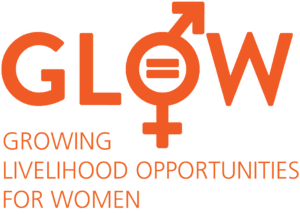Growing Livelihood Opportunities for Women (GLOW)
GLOW’s approach to improving gender equity in India by demonstrating the benefits of a gender-diverse workforce
Context
In India, women’s workforce participation has dropped from 43% to 34% from 2005 to 2022.[1] 33% of non-working women aged 15-59 from urban families with low income are keen to work. Aspiring-to-work women are nearly twice as likely to prefer jobs over entrepreneurship, as it provides timely and agreed-on salaries. 1 in 2 women is willing to work in male-dominated and non-traditional workplaces (e.g., warehouses).[2]
Most entry-level jobs in India are created in high-growth industries [3] such as logistics and flexi-staffing but, women’s participation in these industries is approximately 8%. If women’s participation increases to 24% in these industries, over 1m+ additional women could potentially be employed by 2030. Many jobs (e.g., warehouse packer, delivery agent) in these industries need minimal training and some women are interested in these jobs. Most companies do not employ women due to perceived risks (e.g., performance bias, safety bias, motivation bias—“A woman doesn’t have to work”), unknown benefits (e.g., reduced turnaround time, lower absenteeism, more effective work culture), and gender inequitable hiring and retention practices (e.g., recruitment channels, recruitment messaging, on-boarding, and mentoring are optimized for men). However, the reality is that a gender-diverse workforce is good for business and great for the country.
Our Mission
Our Approach
GLOW signs up companies as ‘partners’, and works with them to co-develop a common understanding of the barriers to employ women, brainstorm ideas to address these barriers, and pilot interventions. Once the practical, effective and sustainable best practices are piloted and proven, partners will roll these out to new locations and new job roles. GLOW will document and disseminate these gender-equitable best practices, making it easier and less risky for non-partners to employ women. Over time, more non-partners will see the shift in industry norms and continue to adopt GLOW’s best practices across new geographies, leading to approximately 1 million jobs for women 5 years after GLOW ends.
GLOW has signed up 19 companies as partners. Since January 2022, partners have run pilots (e.g., effective channels to recruit women, remuneration policies better aligned to women’s needs, gender-disaggregated data collected) leading to the development of effective practices and a 3 percentage point increase in the women employed. Between 2020 and 2023, flexi-staffing, warehousing and last-mile delivery industries have added ~94,000 additional women in jobs. We are hopeful that this trajectory would continue and by 2030, 24% of the workforce will be women and 1m additional women would be in the workforce in these industries.
Our Research
FSG interviewed 6,600 women from households with low income [6] to understand their beliefs, motivations, and preferences towards employment. We found that women want to be in jobs: 1 out of 2 women are either working or seeking a job. 64% of women strongly believe that to be self-reliant, it is important to work. Supporting personal and family expenses is a key reason for over 90% of women working in, or seeking jobs. Nonworking women are nearly twice as likely to prefer jobs over entrepreneurship. However, 69% of key decision-makers (e.g., husbands and fathers) firmly believe that the main role of a woman is to look after the home and the children. 84% of women need to secure their families’ permission to work. Read more about GLOW’s research findings >
Our Industry Focus
- Logistics is the transport and storage of the parcel from the seller to the end-consumer. Roles in the logistics industry include delivery agent, warehouse packer and sorter etc. The logistics industry has the potential to employ approximately 23 million[7] workers by 2031. Today, less than 2%[8] of logistics workers are women. A gender diverse workforce is beneficial for logistics companies and approximately 500,000 women could be employed. Read more about the logistics industry >
- Flexi-staffing is the provision of semi-skilled frontline employees (e.g., retail promoters, tele-calling agents) to companies. Flexi-staffing has the potential to create approximately 1.8 million[9,10] jobs by 2026. Multiple frontline roles could be a good fit for women however, employers face barriers in recruiting and retaining women. Read more about the flexi-staffing industry >
Our Insights for the Government
GLOW has developed insights to boost women’s workforce participation based on interviews with ~6,600 women, engagement with 15+ companies[11], and consultation with 15+ sector experts[12]. Some key insights include disallowing employers from restricting job advertisements only to men, incorporating additional gender diversity metrics within Security and Exchange Board of India’s ‘Business Responsibility and Sustainability Reporting (BRSR)’ format and improving utilization of maternity benefits available under Employees’ State Insurance Corporation (ESIC) by increasing awareness and simplifying the claim process. Read more about our insights >
Download the GLOW Report

- Gender, Inclusive Markets
What Will It Take? FSG's GLOW Report
Our Funders
GLOW is part-funded by:




